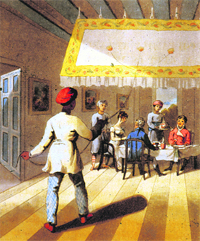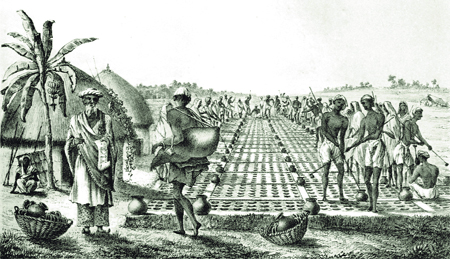Cooling tales from the Raj by Pran Nevile
 An English family at dinner under a hanging punkah. Drawing by Sir Charles D’oyly c. 1810
|
The heat of the Indiansummers scared the English. Before the advent of punkhas and Americanice in early the 19th century, the English dreaded theoppressive heat and miseries of the hot season.
One of the earliestcomments on the Indian summer was recorded by an English surgeon in1774. He refers to his horrible experience of a sultry day “whennot a breath of air was there for many hours; man and every fowl ofthe air so sensibly felt it that some species fell down dead”.The heat, dust and hot winds and the awful devastation they causedearned them the title of “angels of death” by many amemsahib in her letters home. It was even jokingly remarked that thedeadly heat of Calcutta was more dangerous to British life than anyuprising by the natives.
An amusing tool tobattle the heat as recommended to the sahibs by the English editor of CalcuttaGazette in 1783 was to sleep with Indian women to keep themselvescool in the beastly summer of Calcutta. The Portuguese actuallysecured a firman from Emperor Shahjahan to keep Bengali women duringsummer to save themselves from the heat of the delta.
The early Britishsettlers in the 18th century used to wear loose fitting andairy cotton garments at home suitable for the hot climate. Later,however, in the light of increasing political power and prestige theybegan wearing clothing designed for the English climate which wascompletely unsuitable for the Indian summer. Their attire and thehabit of excessive consumption of alcohol were not conducive toalleviate the effects of the heat.
Building defence
As a protection againstthe hot Indian climate, the English built their bungalows withincompounds of shady trees and the rooms had very thick walls and highceilings surrounded by covered verandas. Some wealthy high-rankingsahibs in Calcutta even maintained garden houses on the banks of theriver. Some British officials like Metcalfe and William Fraser, inDelhi followed the Mughal practice and built tehkhanas in theirresidences where they entertained their guests.
Another novel feature ofthe English bungalows was the terrace or housetop accessible through awinding staircase from without and often from within the house also.Many sahibs, especially bachelors, had their cots carried to thehousetop during the hot season, and there, with heaven as theircanopy, they slept during the night.
Some sahibs would set upspecial enclosures on the terrace and put their cots over there.Colesworthy even writes about a person known to him, who used to sleepon the bare terrace with nothing except a pillow and would remainlying there even when it rained. We come across an interesting case ofa young Company civilian who beat the heat by lying down on a cot witha mushq for a pillow and the contents of a second mushq pouredover him. There were others who slept in sheets which had beenpreviously soaked in water. As it was unbearable to sleep indoorsduring the hot weather, some of them selected open spaces in theircompounds.
An indigenous coolingdevice adopted by the sahibs was the installation of tatties made of khus-khusgrass over all openings windows and doors of a house. Tattieswere kept continually wet by a bhishtee, or a water carrier,engaged to throw water against these from outside. This was veryeffective in cooling when winds, hot or cool, blew. The rapidevaporation of sprinkled water and the refreshing odour of khus-khusmade the inner spaces both cool and comfortable. The khus-khus tattieswere highly valued in the upper provinces, which had far more hotwinds than in Calcutta. The use of tatties, however, was alsoprevalent during the Mughal times and the invention of this device isattributed to the Mughal emperor Akbar.
Punkah perfect
The punkah bears thestamp of the Orient and the tropics. The use of hand punkha dates fromolden times. There were many different kinds and sizes of the handpunkha. These were waved to and fro by servants called punkhawalas.There is also a mention of hand fans made of peacock tails andfeathers in South India where servants also held umbrellas over theirmasters. The hanging punkha suspended from the ceiling was introducedtowards the end of the 18th century. Col Yule in HobsonJobson refers to the use of this device by the Arabs andattributes its invention to Caliph Mansur (AD 753-74). It was known asthe Marwaha al Khaish (linen fan). There is no reference toswinging punkah in Mughal India or in the East India Company recordsuntil 1780.
William Hicky in 1785records the luxury of hanging fans while sahibs were having theirmeals. It is a French seaman Captain de Grandpre who firstdescribes the Calcutta punkha in 1790. “In many houses, there wasa large fan, hanging from the ceiling over the eating table, of asquare form and balanced on an axle fitted to the upper part of it. Aservant standing at one end of it, puts it in motion by means of acord which is fastened to it in the same manner as he would ring abell”.
According to oneauthority, hanging punkhas were accidentally invented by a Eurasianclerk in Calcutta when he suspended the leaf of a table which waswaved by a visitor to and fro resulting in a breath of cool air, whichsuggested the idea of developing this device.
Besides the punkah,there was another mostly forgotten device used in some British homesfor beating the heat called the ‘thermantidote’. It was a huge boxcontaining a revolving hand-operated fan like a steamboat’s paddlewith tatties- fitted windows on each side. The hot air sucked in bythis gadget passing through moist tatties filled the entire house withcool air, bringing relief to the memsahib, who would write home aboutvarious modes of cooling during the ghastly Indian summer. There is amention of this novel device in the writings of Fanny Parks in 1831.This invention is attributed to Dr George Green Spilsbury, who came toIndia in 1823 and was, for some years, surgeon to the Saugor PoliticalAgency.
Before the introductionof ice, an important servant of the sahib’s household was the Abdar.He was entrusted with the job of cooling the water, wines, beer andother table delicacies, which depended more on their refreshingcoolness than flavour for value and acceptance. He was the walkingrefrigerator of those days and went with his master to every dinnerparty for cooling the master’s wine, using saltpetre in a containerfor the bottle.
Imported ice
|
|
The introduction ofAmerican ice in 1833 was an event of great jubilation and feasting inCalcutta. The American ice replaced the mountain ice brought down atheavy cost and inconvenience, and the other native ice produced in icepits during winter nights and preserved for the summer, entailingcolossal wastage. Small earthen pots filled with water were placed inan open field, and in the morning the coating of ice formed in thecold temperature of the night was collected and stored in ice-pits.
It was after more than20 years of experiment in the early 19th century that anAmerican entrepreneur, Fredrick Tudor, succeeded in transporting icefrom a cold to a hot climate.
The ice blocks cut fromthe frozen ponds rented near Boston were stored in an icehouse beforeloading them on board the vessel, which had an in-built icehouse. Thefirst shipment of American ice arrived in Calcutta by S.S. Tussany inSeptember, 1833, after a four-month voyage around the Cape. Wrapped infelt and pine saw dust, two-thirds of the ice cargo in solid form wasreceived with great excitement in Calcutta. So much so that theGovernor-General Lord Bentinck presented an inscribed silver-gilt cupto the ship’s captain William C. Rogers for having successfullylanded the first shipment of American ice in India. This encouragedthe exporter Fredrick Tudor to make ice shipments to Bombay and Madrasalso. Icehouses were soon constructed at all three ports to store theprecious ice cargo and preserve it against heat. There was a growingdemand for this crystal clear ice among the local European populationas well as wealthy Indians. Selling at four annas a seer, half theprice of Indian ice, the American ice became popular with all whocould afford it. Tudor made a fortune by carrying on this ice tradefor over 30 years till the technology of making ice was introduced inIndia.
Super sola
Another useful device,which served as a shield against the killer sun of the tropics was thesola topi. People had used various kinds of head covers forprotection against the sun’s rays. It was after 1857 that the solatopi attained its supremacy and eliminated all other kinds of sunhats. It became even a symbol of the Imperial might as no sahib everappeared in public without a hat. They wore them even during the rainand some sahibs got them enamelled to make them waterproof.
The heat, no doubt,haunted the English and even determined their life-style in India.After consolidating their hold on major parts of India, they createdtheir “little Englands” at the hill stations withEnglish-style cottages. These relics of the Raj with their coolclimate, lush greenery and glorious views of snow-covered peaksoffered a pleasant escape from the grilling heat of the plains. Simla,the pride of the`A0Raj, became the summer capital of India from 1830followed by Ooty for Madras, Nainital for Lucknow, Mahableshwar forBombay and Darjeeling for Calcutta.
With their holidayatmosphere enriched by picnics and parties in the cool and picturesquesurroundings, the hill stations provided an escape from the heat, arefuge for the invalid and the bored and a fun place for the pleasureseekers, both sahibs and memsahibs. Emily Eden, sister ofGovernor-General Auckland, described Simla as “the nearest placeto dear home that one could hope for in this dreadful country”.From 1864, Simla became the seat of the government from April tillOctober, and the ruling elite and their staff would move en bloc fromCalcutta to run the administration from there. With Kipling swritings, Simla acquired a reputation for merriment, gaiety, highliving and not so harmless flirting. Nevertheless, the hill stationsbecame popular centres for rest and recreation in summer, especiallyfor memsahibs, who supposedly wilted under the heat much more rapidlythan their men folk.
